Land Invertebrates
Media
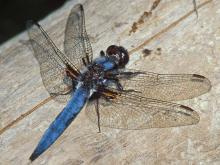
Species Types
Scientific Name
Ladona deplanata
Description
The male blue corporal has a rather dark blue body, a black head, and dark marks at the wing bases. Females and young males are brownish and have two short "corporal" stripes on the side of the thorax, behind the eye.
Media

Species Types
Scientific Name
Tramea lacerata
Description
The black saddlebags is a dragonfly with memorable markings. Two dark blotches on each hindwing look like saddlebags.
Media
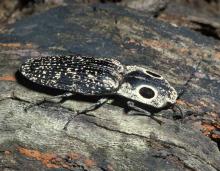
Species Types
Scientific Name
Alaus oculatus
Description
The eyed click beetle is only one of about 1,000 species of click beetles in North America. Most of the others are drab in comparison.
Media

Species Types
Scientific Name
Megarhyssa atrata
Description
The female black giant ichneumon wasp deposits her eggs through wood. The larvae eat the grubs of wood-boring insects.
Media

Species Types
Scientific Name
Megarhyssa macrurus
Description
The female long-tailed giant ichneumon wasp deposits her eggs through wood. The larvae eat the grubs of the pigeon tremex, a wood-boring horntail wasp.
Media
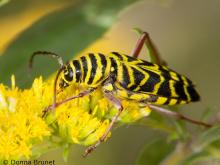
Species Types
Scientific Name
Megacyllene robiniae
Description
The locust borer is a longhorned beetle whose larvae tunnel into the trunks of black locust. The colorful black and yellow adults are often seen in late summer as they feed on the pollen of goldenrod and other flowers.
Media
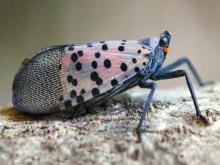
Species Types
Scientific Name
Lycorma delicatula
Description
The spotted lanternfly has not yet been found in Missouri, but it is present in several eastern states. It has the potential to damage our forests and food supply by feeding destructively on trees and crops.
Media

Species Types
Scientific Name
Entypus aratus, E. unifasciatus, E. fulvicornis, and others
Description
Spider wasps in genus Entypus are bluish black and usually have some amount of amber color on their dark, smoky wings. Some species have bright yellow antennae.
Media
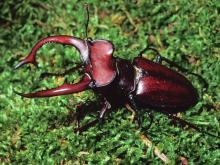
Species Types
Scientific Name
Lucanus elaphus
Description
The giant stag beetle is enormous, the males reaching 1½ inches in length without the mandibles, and nearly 2½ with them. Look for them on rotting logs in forests in early summer. They’re also attracted to lights.
Media

Species Types
Scientific Name
Epitheca spp.
Description
Female baskettails have a specially adapted, upturned abdomen tip, which allows them to carry around their egg masses in a little, orangish glob.
See Also



Media

Species Types
Scientific Name
Cisseps fulvicollis
Description
The yellow-collared scape moth is more often “orange-collared.” And whether you think it looks more like a firefly or a wasp, it’s still a moth!
Media

Species Types
Scientific Name
Nearly 150 species in North America north of Mexico
Description
Slim, delicate plume moths are instantly recognizable by their T-shaped silhouette, long legs, and muted shades of tan and brown. It can be hard to separate the various species.
Media

Species Types
Scientific Name
Pyrrharctia isabella
Description
Not many people know the adult Isabella tiger moth when they see one, but we’re all acquainted with its caterpillar, the woolly worm, or woolly bear.
About Land Invertebrates in Missouri
Invertebrates are animals without backbones, including earthworms, slugs, snails, and arthropods. Arthropods—invertebrates with “jointed legs” — are a group of invertebrates that includes crayfish, shrimp, millipedes, centipedes, mites, spiders, and insects. There may be as many as 10 million species of insects alive on earth today, and they probably constitute more than 90 percent all animal species.





















